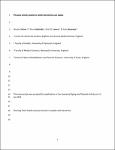Physical activity patterns within dementia care dyads
| dc.contributor.author | Farina, N | |
| dc.contributor.author | McArdle, R | |
| dc.contributor.author | Lowry, RG | |
| dc.contributor.author | Banerjee, S | |
| dc.date.accessioned | 2024-01-16T10:57:22Z | |
| dc.date.available | 2024-01-16T10:57:22Z | |
| dc.date.issued | 2024-03 | |
| dc.identifier.issn | 1543-267X | |
| dc.identifier.issn | 1543-267X | |
| dc.identifier.uri | https://pearl.plymouth.ac.uk/handle/10026.1/21909 | |
| dc.description.abstract |
Previous research has explored the physical activity habits of people with dementia and their family carers separately, with little consideration of how physical habits are associated within dyads. In this observational study, we sought to explore the relationship between people with dementia and their carers’ physical activity, at a group level and at a dyadic level. Twenty-six participant dyads (persons with dementia and their carer spouses) were asked to wear an accelerometer for 30 days continuously. Comparisons were made at a group level and a dyadic level. People with dementia did not participate in significantly more moderate to vigorous physical activity (M = 15.44 min/day; SD = 14.40) compared with carers (M = 17.95 min/day; SD = 17.01). Within dyads, there were moderately strong associations between daily moderate to vigorous physical activity (r = .48–.54), but not with overall activity levels (r = .24). Despite physical activity habits remaining relatively low within people with dementia and carers, respectively, moderate to vigorous physical activity levels appear to be correlated within dyads. Understanding mutual influence on physical activity levels within dyads is an important pathway to promote an active lifestyle. | |
| dc.format.extent | 1-8 | |
| dc.format.medium | Print-Electronic | |
| dc.language | eng | |
| dc.publisher | Human Kinetics | |
| dc.subject | exercise | |
| dc.subject | caregiver | |
| dc.subject | spouse | |
| dc.subject | accelerometer | |
| dc.subject | habitual | |
| dc.title | Physical activity patterns within dementia care dyads | |
| dc.type | journal-article | |
| dc.type | Article | |
| dc.type | Early Access | |
| plymouth.author-url | https://www.ncbi.nlm.nih.gov/pubmed/38437844 | |
| plymouth.publisher-url | http://dx.doi.org/10.1123/japa.2023-0078 | |
| plymouth.publication-status | Published | |
| plymouth.journal | Journal of Aging and Physical Activity | |
| dc.identifier.doi | 10.1123/japa.2023-0078 | |
| plymouth.organisational-group | |Plymouth | |
| plymouth.organisational-group | |Plymouth|Faculty of Health | |
| plymouth.organisational-group | |Plymouth|REF 2021 Researchers by UoA | |
| plymouth.organisational-group | |Plymouth|Users by role | |
| plymouth.organisational-group | |Plymouth|Users by role|Academics | |
| plymouth.organisational-group | |Plymouth|REF 2021 Researchers by UoA|UoA04 Psychology, Psychiatry and Neuroscience | |
| plymouth.organisational-group | |Plymouth|Faculty of Health|Peninsula Medical School | |
| plymouth.organisational-group | |Plymouth|REF 2028 Researchers by UoA | |
| plymouth.organisational-group | |Plymouth|REF 2028 Researchers by UoA|UoA04 Psychology, Psychiatry and Neuroscience | |
| dc.publisher.place | United States | |
| dcterms.dateAccepted | 2024-01-12 | |
| dc.date.updated | 2024-01-16T10:57:21Z | |
| dc.rights.embargodate | 2024-3-23 | |
| dc.identifier.eissn | 1543-267X | |
| rioxxterms.versionofrecord | 10.1123/japa.2023-0078 |


